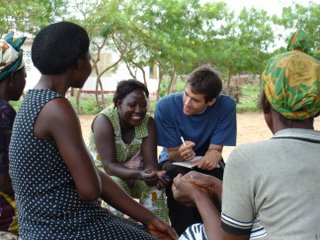
This topic obviously deserves further research and investigation but without published research specific to Mormons the ideas will have to rely on my own conversations, observations and a bit of intuition from my own experiences so it is by no means authoritative nor expert. Also, bear in mind that I am only trying to explain what is currently happening, not passing judgement. Here is my take on the current culture of philanthropy in the Mormon community:
1. Mormons do mainly charity not strategic philanthropyThis is not good or bad this is just what we do. Mormons are generally happy with one-off charitable gifts/activities and they do so frequently and freely. Disaster relief is therefore a great fit for the
LDS Church which they do very well and they are starting to make a name for themselves in that space, which I think is fantastic. Our ability to mobilize a large army of volunteers swiftly and orderly with smiles on their faces and not afraid to get their hands dirty is largely unmatched in the world.
The Mormon community in general is not involved in what could be called 'strategic' philanthropy meaning professional analysis, ongoing intervention, and evaluation, whether doing so themselves or supporting such efforts. Even activities of the institutional church such as employment centers or the
Perpetual Education Fund are not completely 'strategic interventions', limited by their operations being carried out almost exclusively by short-term volunteers with little expertise in analyzing and refining such interventions. Not to take away from what the PEF is accomplishing but I think the implementation is still catching up to the vision.
2. Mormons trust the LDS Church with their moneyWhen an average latter-day saint or a wealthy
LDS businessman is considering a philanthropic donation the brand of the Church is an instant vetting process. The Church is 1) extremely conscious of treating donated money as sacred funds, 2) they have a long track record of proven fiscal responsibility and 3) the fact that they use volunteers means extremely low overhead (which is appealing on the surface but I'll toss in my own opinion--low overhead is a very poor indicator of impact or social return on investment). So, many Mormons will give gifts to the Church before they would consider giving money outside of the Church for other philanthropic activities. I think this phenomenon is also connected to the general isolation of the church for most of its history; general members simply have not been exposed to alternate options of philanthropy.
3. Mormons are extremely conservativeMormons have an interesting relationship with government and
gov't welfare programs so that there is a constant battle over words in
LDS charitable activities. I sense that there is such an adverse taste to "socialism" and/or hand-out philanthropy that some do not like the connotation of 'social' even in words like "social entrepreneurship" or "social issues." Mormons have liked to use the word "self-reliance" but even that word has not been accepted by everyone, some do not like the word on grounds that it can appear to mean we somehow do not rely on the Lord as we should. See Hugh Nibley
Work we Must but the Lunch is Free. So, it goes back and forth. Generally, the church and the members are weary to support 'liberal' activities. I think that somewhat explains why Mormons have been drawn to activities such as
microcredit and educational loans because they mix charity with conservative practicality and values.
4. Mormons prefer anonymous giving
This is more intuition than hard research but I get the sense that Mormons prefer anonymity in their giving. The roots likely come from the scriptural injunction for anonymous giving from the Sermon on the Mount but that would be common among all Christians. I think some give through the Church to preserve their anonymity and at the same time get satisfaction that the Church is, instead of themselves, getting the public relations attention. There is also a sense that Mormons will just go about their work, whether it's recognized by the wider world or not, which is a spirit that has accompanied most of their operations, so why not their philanthropic activities. I really like this cultural phenomenon.
5. High competition and demand among a relatively small pool of high net worth individuals.The body of
LDS philanthropists is relatively small and so the demand for their wealth is great among all the programs of the church: Temple building,
BYU, Humanitarian Department, etc. let alone all the independent Mormon-run charities and the philanthropic world at large. Additionally, although Mormons have a strong showing and reputation in business, most of the wealth is new wealth so they do not have the same size endowments or foundations as some of the East Coast old-money foundations. This goes back to the history of the Mormons being chased out of the United States and the demographics of the early pioneers of the church.
I could keep going but there is enough here to discuss...
how did I do? Do you see the same patterns? What goes on in your mind when you are considering donating to the Church above and beyond tithing donations?







